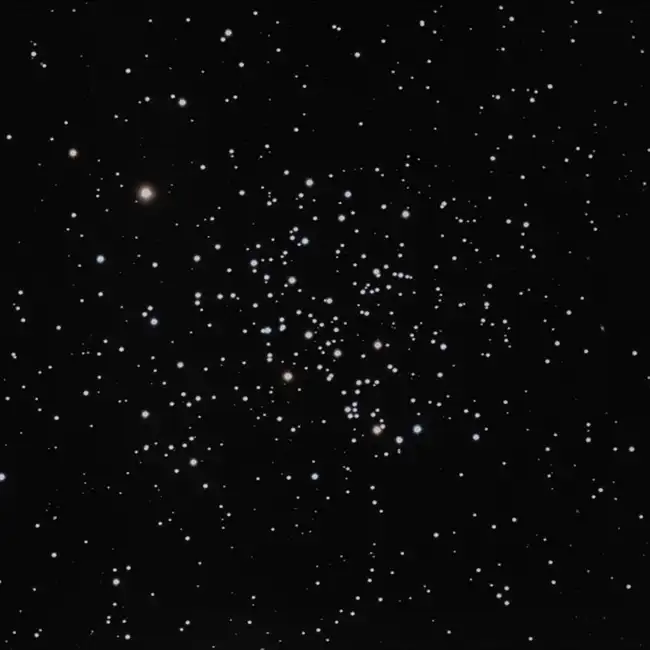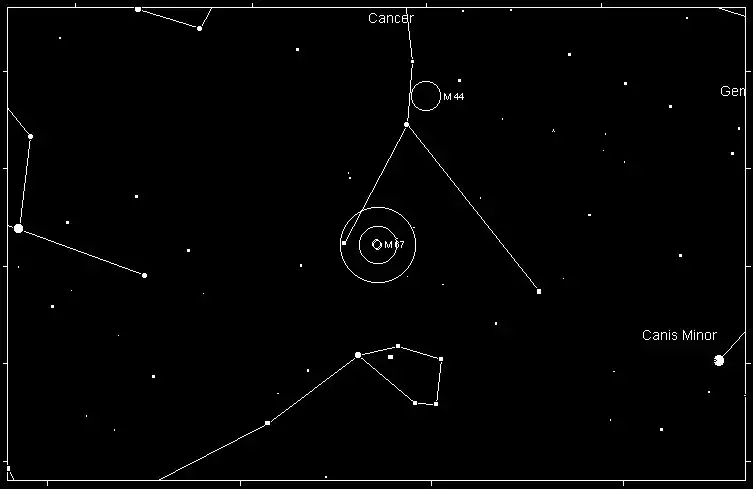Messier 67 (M67), also known as NGC 2682, is an open star cluster located in the constellation of Cancer. This cluster is particularly interesting because it is one of the oldest open clusters known, with an estimated age of about 3.2 to 4.8 billion years. It contains roughly 500 stars, including several red giants, white dwarfs, and sun-like stars. M67 is a rich cluster and has been extensively studied, especially because its stars share a similar age and chemical composition, providing valuable insights into stellar evolution.
Magnitude
Messier 67 has an apparent magnitude of approximately 6.1, making it a challenge to spot with the naked eye but relatively easy to observe with a small telescope or binoculars under dark skies. Its combined brightness is comparable to that of a dim star, so optical aids are necessary to resolve its individual stars and appreciate its full structure.

Visibility and Seasonality
M67 is best viewed during the late winter and spring months in the Northern Hemisphere, particularly from January to April. During this time, Cancer, the constellation that hosts M67, is high in the sky during the evening hours, offering optimal viewing conditions.
Constellation and Location
Messier 67 is situated within the constellation of Cancer, the Crab. Cancer is a relatively faint constellation, positioned between the more prominent constellations of Gemini to the west and Leo to the east. Despite its faintness, Cancer holds some interesting deep-sky objects, with M67 being one of the most notable.
How to Find Messier 67
To locate Messier 67, start by identifying the constellation of Cancer. The constellation's most prominent feature is an asterism known as the "Beehive Cluster" or M44 (Praesepe), which is a brighter and more easily spotted open cluster. M67 is located approximately 1.5 degrees west of Alpha Cancri (Acubens), the star that marks the southeastern corner of the crab's "body."
Once you've identified Alpha Cancri, move your telescope slightly to the west, and you should be able to spot M67. With a small telescope, the cluster will appear as a faint smudge of light, but increasing magnification will resolve individual stars, giving a clearer view of this ancient stellar group.

History
Messier 67 was first discovered by the German astronomer Johann Gottfried Koehler in 1779. Charles Messier, the French astronomer who compiled the famous Messier Catalog of deep-sky objects, included M67 in his catalog in the same year. Messier's catalog was initially designed to help astronomers distinguish between permanent celestial objects, like nebulae and star clusters, and transient ones, such as comets, which Messier was keenly interested in discovering.
M67's significance extends beyond its historical cataloging. Its advanced age and the fact that it contains stars similar to our Sun make it an essential subject for studying stellar evolution. In particular, M67's stars have been used to investigate the chemical compositions and life cycles of stars, providing a benchmark for understanding the processes that shape star formation and destruction.
One of the fascinating aspects of M67 is its near-uniformity in the age and chemical composition of its stars, which has led to numerous studies on how clusters like these evolve over time. Moreover, M67 has been a focal point in discussions about the "Sun's siblings"—stars that may have formed in the same molecular cloud as the Sun.
Conclusion
Messier 67 is a captivating open cluster nestled in the relatively faint constellation of Cancer. While it requires optical assistance to view, it is an object of great interest to both amateur and professional astronomers. Its rich history, coupled with its valuable role in understanding stellar evolution, makes M67 a must-see for those exploring the winter and spring skies. Whether you're an experienced observer or a curious beginner, locating and observing M67 offers a rewarding glimpse into the ancient past of our galaxy.
